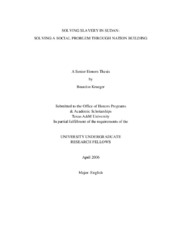| dc.description.abstract | Almost unique in the world, chattel slavery persists in Sudan into the 21st century. The U.N. and various NGOs have provided evidence that slavery exists in modern Sudan and that the government has done little, if anything, to stop it. The efforts of NGOs to stop slavery have largely failed, and perhaps even fueled the slave trade by paying to free slaves, which created a market for them. This thesis examines the complex history of Sudan that led to 2006, analyzes modern abolishment efforts to discover why they have failed, and develops a solution based on a Nations’ “Hierarchy of Needs” that can be applied in Sudan and is practical on political, economic, and cultural levels. My history analysis hinged on a review of academic texts, government documents, credible journalism, and slave testimonials. Recurring patterns in that history were identified and explained so as to provide a basis of issues, which the solution must address. I adapted Maslow’s Hierarchy of Needs to define three necessities, Security, Sovereignty, and Economy, and two sustaining needs, Identity and Adaptation. Each need is reliant on its predecessors in the Hierarchy and when employed together, will successfully build Sudan into an economic and diplomatic partner of the world. The establishment of security and peace in Sudan are fundamental to cutting off slave trading routes and establishing Sudan’s sovereignty and subsequent improved diplomatic relations. The Sudanese government can then use these improved diplomatic relations to help diversify their economy through foreign investment and international trade based on improving labor standards for export quotas, which will reduce slave markets through moral spillover from industry leaders who were forced to improve labor standards to stay in business. Economic growth fosters a national identity that provides the impetus for Sudan to undergo a moral reform that may lead to a final crackdown on slavery. The resultant solution can be applied to Sudan in 2006 or at any point in Sudan’s progress in the future, but will be most effective if applied to establishing security in Darfur and built from that peace. | en |


